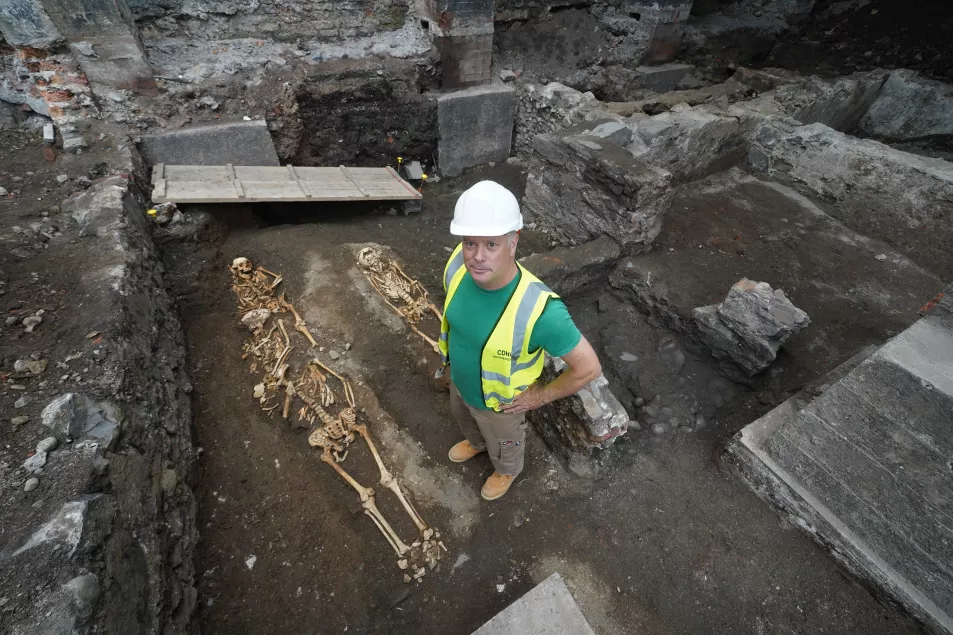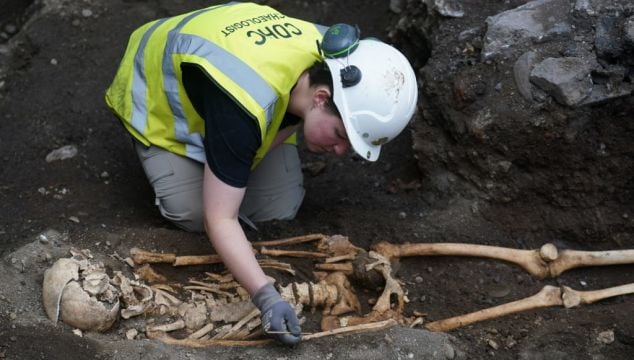Burial sites dating back more than one thousand years have been discovered during excavations for a new hotel in Dublin city centre.
Around 100 skeletal remains from the Middle Ages were found in an area around Capel Street where an abbey, St Mary’s, once stood.
At least two of the remains are believed to date back to the early 11th century.
The abbey used by the Savigniac and Cistercian orders opened in the 12th century. Carbon dating of one of the graves discovered predates that by one hundred years, indicating the presence of a Christian settlement on the site prior to St Mary’s being built.

The excavations have been commissioned by the Beannchor hospitality group, which is developing its new Bullitt Dublin hotel on a site that once housed the old Boland’s Bakery.
The archaeological investigations also unearthed the foundations of buildings dating back to the 1600s.
The finds were discovered close to a former Presbyterian Meeting House dating from 1667.
Parts of a domestic house known as the ‘Dutch Billies’ has also been found. It was constructed around 1700 by settlers who came to Dublin after King William of Orange ascended to the English throne following the Battle of the Boyne in 1690.
While the skeletal remains will be painstakingly excavated, cleaned and sent for further analysis, before ultimately being given to the National Monuments Services, the other structures found during the examination of the site are set to be incorporated into the design of the new hotel complex.

The 17th century Presbyterian Meeting House will be central to the development of a new bar and restaurant concept. The ‘Dutch Billies’ house will also be preserved while a building with surviving ovens from the Boland’s Bakery dating from 1890 will be renovated and repurposed.
Edmond O’Donovan, director of excavations for Courtney Deery Heritage Consultancy (CDHC), described the significance of the finds.
“In its day, St Mary’s Abbey was Ireland’s largest and most wealthy medieval abbey,” he said.
“It was demolished after 1540 when the monastery was disbanded by Henry VIII and was later the site of a 17th century Presbyterian Meeting House.”
He added: “One of the things that was intriguing and exciting about the excavation is that we found an early burial or at least a number of burials that we suspect to be quite early.
“We have one that’s carbon dated to the 11th century and we have a second burial that was found with a diagnostic stick pin from the 11th century.
“And that suggests that there was an earlier Christian and potentially monastic foundation here which predates the Savigniac and Cistercian Abbey.”
Beannchor has undertaken similar restoration of historic buildings in the past, including Belfast’s Merchant Hotel, which was a former bank, but it said the Dublin project is by far its biggest and most complex project to date.

Bill Wolsey, managing director for Beannchor, said it was impossible to have foreseen what the project would entail at its outset in 2017.
“As time went on, we began to understand just how complex this project may be,” he added.
“The sheer magnitude of the archaeology on the site and financial cost might have deterred other developers, but as our business is rooted in embracing and reimaging sites of heritage interest, and bringing them back to public use, we stuck with it, despite the consequences, rising construction costs and inflation.
“Through close collaboration with Dublin City Council, our team of archaeologists, architects and building contractors, we have uncovered a fascinating window into the city’s past. Our archaeology team, led by Ed at CDHC, have been on hand to advise and support us on this journey.
“Great care has been taken to preserve and incorporate elements of these early surviving buildings into the new development, on what we now know is one of the most significant heritage sites in the city.
“While this has been a complex project that’s been years in the planning, the whole process has enriched us as hoteliers and developers. We look forward to continuing our journey in collaboration with Dublin City Council as we collectively endeavour to bring this important, hidden site back to public use.”
As part of the first phase of the development, Beannchor plans to reopen a Victorian laneway stretching between Capel Street and Meeting House Lane, which has been closed to the public for more than 140 years.
A number of new dining options and a bar are planned for this part of the complex, which it is hoped will open in the first half of 2024.
The new Bullitt Dublin hotel is expected to follow around 12 months later.







